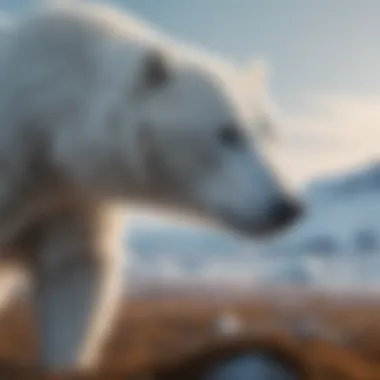Unveiling the Impact of Biodiversity Loss: Examining Examples and Consequences


Nature Topic Overview
Loss of biodiversity is a critical issue that demands our attention, resonating through ecosystems worldwide. The delicate balance of life on Earth is being disrupted, leading to far-reaching consequences that affect all living beings, from the tiniest insects to the majestic giants of the jungle.
Fun Facts and Trivia
One intriguing fact is that the Amazon Rainforest, known as the 'lungs of the Earth,' harbors more plant species in a single hectare than the entire continent of North America. This biodiversity hotspot is home to a staggering array of flora and fauna, emphasizing the richness of ecosystems that we must strive to protect and preserve for future generations.
Wildlife Explorations
Delving into the depths of the ocean, we encounter the mesmerizing world of coral reefs teeming with life. From vibrant clownfish darting among the anemones to graceful sea turtles gliding through the azure waters, these fragile ecosystems are hubs of biodiversity, showcasing the interconnectedness of all living organisms.
Environmental Awareness
Understanding the significance of biodiversity conservation is crucial for sustaining life on Earth. By safeguarding ecosystems and promoting sustainable practices, we can mitigate the impact of human activities on the environment, fostering a harmonious coexistence between nature and humanity.
DIY Nature Activities
Embark on a journey of discovery by creating a miniature ecosystem in a jar, observing how plants and animals interact within a closed environment. Engage in bird-watching sessions to appreciate the avian diversity in your local surroundings, fostering a deep connection with nature through hands-on experiences.
Introduction to Biodiversity
Biodiversity, a crucial facet in the tapestry of life, encompasses the variety and variability of living organisms found on Earth. Understanding this intricate web of life forms is paramount to comprehend the functioning of ecosystems. Within this realm, Genetic Diversity refers to the array of genes present in different species, ensuring resilience and adaptability. It safeguards against diseases and environmental changes, playing a vital role in evolution. Species Diversity, on the other hand, reflects the richness of different plant and animal species coexisting in a habitat, contributing to ecological balance. Ecosystem Diversity delves into the variety of habitats, communities, and ecological processes that constitute our natural world, fostering stability and sustainability.
Defining Biodiversity
Genetic Diversity
Genetic Diversity lies at the core of evolutionary processes, enabling species to withstand environmental pressures and adapt to changing conditions. The intricate mix of genes within populations ensures the survival and viability of species over time. This diversity acts as a reservoir of genetic traits, promoting resilience and innovation in the face of challenges. Despite its critical role, genetic diversity faces threats from habitat loss, pollution, and climate change, necessitating conservation efforts to preserve invaluable genes for future generations.
Species Diversity
Species Diversity showcases the variety of organisms inhabiting Earth, ranging from microscopic bacteria to majestic mammals. This diversity not only enhances ecosystem resilience but also provides aesthetic and intrinsic value to our planet. Each species plays a unique role in the functioning of ecosystems, highlighting the interconnectedness of life forms. However, species diversity faces a perilous decline due to human activities like habitat destruction and pollution, underscoring the urgency of conservation measures to safeguard the rich tapestry of life.
Ecosystem Diversity


Ecosystem Diversity illustrates the myriad of habitats and ecological communities that adorn our planet, from lush rainforests to sprawling deserts. These diverse ecosystems harbor a wealth of species, each adapted to specific environmental conditions, contributing to the planet's ecological richness. However, human actions such as deforestation and urbanization pose significant threats to these ecosystems, disrupting delicate balances and diminishing biodiversity. Preserving ecosystem diversity is paramount to ensuring the long-term sustainability of our planet's natural heritage.
Significance of Biodiversity
Ecological Stability
Ecological Stability underpins the functioning of ecosystems, ensuring resilient responses to environmental changes. Biodiversity fosters stability by enhancing ecosystem productivity, regulating climate, and mitigating natural disasters. However, the loss of biodiversity jeopardizes this balance, leading to ecosystem degradation and increased vulnerability to disturbances. Safeguarding biodiversity is essential to maintain ecological stability and preserve the planet's natural resilience against unforeseen challenges.
Human Well-being
Human Well-being stands intricately linked to biodiversity, with nature providing a myriad of benefits essential for our health and livelihoods. Biodiversity contributes to food security, medicine discovery, and spiritual well-being, enriching human lives in ways both seen and unseen. Nonetheless, human activities threatening biodiversity, such as overexploitation and habitat destruction, jeopardize these benefits and pose risks to global well-being. Understanding the intricate link between biodiversity and human well-being is key to fostering sustainable relationships with nature.
Economic Benefits
Economic Benefits derived from biodiversity span a wide spectrum of industries, from agriculture to pharmaceuticals, underpinning global economies. Natural resources, ecosystem services, and biotechnology products form the backbone of numerous economic activities, driving innovation and growth. However, the depletion of biodiversity through unsustainable practices endangers these economic benefits, creating long-term risks for industries reliant on nature's abundance. Promoting sustainable practices and preserving biodiversity are essential for securing economic prosperity and fostering a harmonious relationship between nature and economy.
Loss of Biodiversity
Loss of Biodiversity is a critical topic explored in this article. The significance of maintaining biodiversity cannot be overstated, as it forms the basis of healthy ecosystems. Biodiversity encompasses genetic diversity, species diversity, and ecosystem diversity, each playing a vital role in the functioning of our planet's ecosystems. Understanding the implications of biodiversity loss is crucial in highlighting the interconnectedness of all living organisms and the environment. By delving into the causes, examples, and consequences of biodiversity decline, this section aims to shed light on the urgent need for conservation efforts to preserve our planet's rich biological diversity.
Causes of Biodiversity Loss
Habitat Destruction
Habitat Destruction stands as one of the primary drivers of biodiversity loss. The alteration or elimination of natural habitats due to human activities such as logging, urban development, and agriculture results in the displacement and extinction of numerous species. The key characteristic of Habitat Destruction lies in its pervasive nature across various ecosystems, leading to the fragmentation and degradation of habitats essential for diverse flora and fauna. While providing economic benefits in the short term, Habitat Destruction poses long-term disadvantages by jeopardizing ecological balance and biodiversity. The unique feature of Habitat Destruction is its irreversible impact on ecosystems, making it a critical concern in biodiversity conservation efforts.
Climate Change
Climate Change presents another significant threat to biodiversity. The alteration of global climate patterns due to human-induced activities like burning fossil fuels and deforestation leads to habitat disruption and loss. The key characteristic of Climate Change is its widespread impact on diverse ecosystems, influencing the distribution and survival of species worldwide. While Climate Change may offer short-term advantages in certain sectors, such as agriculture, its long-term consequences on biodiversity are profound. The unique feature of Climate Change lies in its unpredictable and escalating effects on ecosystems, posing challenges for conservation strategies.
Pollution
Pollution, whether from industrial, agricultural, or domestic sources, poses a severe threat to biodiversity. The contamination of air, water, and soil with pollutants disrupts ecosystems and endangers species survival. The key characteristic of Pollution is its insidious nature, gradually degrading habitats and affecting species health. While Pollution may bring short-term benefits to human activities, such as increased productivity, its long-term disadvantages on biodiversity are undeniable. The unique feature of Pollution is its pervasive reach across different ecosystems, highlighting the interconnectedness of environmental health.
Overexploitation


Overexploitation of natural resources, including overfishing, hunting, and logging, contributes significantly to biodiversity loss. The excessive extraction of resources beyond their capacity for regeneration results in the depletion of species populations and disturbances to ecosystems. The key characteristic of Overexploitation is its immediate impact on targeted species, leading to population declines and cascading effects on entire ecosystems. While Overexploitation may offer short-term economic benefits, its long-term disadvantages include the loss of vital species and disruptions to ecological functions. The unique feature of Overexploitation is its direct link to human activities and consumer demand, emphasizing the need for sustainable resource management.
Examples of Biodiversity Loss
Deforestation in the Amazon Rainforest
Deforestation in the Amazon Rainforest represents a prominent example of biodiversity loss. The widespread clearing of forests for agriculture, logging, and development purposes has led to the destruction of invaluable habitats hosting a vast array of plant and animal species. The key characteristic of Deforestation in the Amazon Rainforest is its scale, with vast tracts of pristine forest being lost every year. While offering short-term economic gains, such as land for agriculture, deforestation brings long-term disadvantages like habitat fragmentation and species extinction. The unique feature of Deforestation in the Amazon Rainforest is its impact on climate regulation and biodiversity hotspots, emphasizing the need for sustainable land use practices.
Coral Reef Bleaching
Coral Reef Bleaching exemplifies the detrimental impact of environmental stressors on marine biodiversity. The bleaching phenomenon, triggered by rising water temperatures and ocean acidification, results in the depletion of colorful algae living within coral tissues, leading to coral death. The key characteristic of Coral Reef Bleaching is its sensitivity to environmental changes, posing a threat to the intricate marine ecosystems dependent on coral reefs. While offering short-term tourism benefits, coral reef bleaching poses long-term disadvantages like reduced fish populations and coastal protection. The unique feature of Coral Reef Bleaching is its global relevance, affecting reefs worldwide and calling for immediate conservation actions to mitigate further loss.
Extinction of Species
The Extinction of Species represents the ultimate consequence of biodiversity loss. Human activities such as habitat destruction, climate change, and overexploitation drive numerous species to extinction, disrupting the delicate balance of ecosystems. The key characteristic of Extinction of Species is its irreversible nature, leading to the permanent loss of unique genetic information and ecological roles. While providing short-term industrial benefits, such as resource exploitation, species extinction brings long-term disadvantages like ecosystem instability and reduced resilience. The unique feature of Extinction of Species is its impact on ecosystem dynamics, highlighting the importance of biodiversity conservation to prevent further loss.
Consequences of Biodiversity Decline
In this section, we delve into the critical consequences of biodiversity decline and its far-reaching impacts on our environment. The loss of biodiversity not only diminishes the richness of our ecosystems but also poses significant challenges to our overall well-being. It is imperative to understand the intricate web of connections within ecosystems and how any disruption can have cascading effects.
Ecological Impact
- Disruption of Ecosystem Services: The disruption of ecosystem services is a fundamental aspect of biodiversity decline. It refers to the breakdown of essential functions that ecosystems provide, such as water purification, pollination, and soil fertility. This disruption can lead to a domino effect, affecting various organisms and ultimately impacting human societies that depend on these services for survival. The unique feature of ecosystem services lies in their invisible yet indispensable nature, making them vital for the sustenance of life on Earth.
- Loss of Keystone Species: When keystone species vanish due to biodiversity decline, it can have substantial repercussions on the entire ecosystem. These species play a disproportionate role in maintaining balance and diversity within their habitats. Their absence can trigger a chain reaction of ecosystem destabilization, highlighting the pivotal importance of even seemingly minor species. The significance of keystone species underscores the delicate interplay of nature and the fragility of ecological systems.
- Imbalance in Food Chains: Imbalance in food chains is another critical consequence of biodiversity decline. As species disappear or populations dwindle, food chains become disrupted, leading to overpopulation of certain species and decline in others. This imbalance can result in widespread ecological issues, including increased competition, spread of disease, and altered habitats. Understanding the dynamics of food chains is essential in grasping the intricate relationships that shape ecosystems and the repercussions of disrupting these delicate balances.
Social and Economic Ramifications
- Impact on Agriculture and Food Security: The impact on agriculture and food security stemming from biodiversity loss is profound. Agricultural systems rely on diverse ecosystems for essential services like pollination, pest control, and soil health. As these services falter, agricultural productivity decreases, leading to food shortages and diminished quality. The unique aspect of this impact lies in its direct link to human sustenance, highlighting the critical need to preserve biodiversity for food security.
- Reduction in Medicinal Resources: The reduction in medicinal resources due to biodiversity decline is a cause for concern. Many pharmaceuticals and traditional remedies are sourced from plants and animals found in diverse ecosystems. As species disappear, potential medicinal discoveries are lost, impacting healthcare and scientific advancements. The distinct feature of medicinal resources reduction emphasizes the valuable knowledge and potential treatments that may be overlooked with biodiversity depletion.
- Threat to Tourism and Recreation: Biodiversity decline poses a significant threat to tourism and recreation, affecting industries reliant on natural environments for their appeal. Tourist attractions, such as national parks and wildlife reserves, draw visitors seeking unique experiences and encounters with diverse flora and fauna. With the decline of biodiversity, these attractions lose their allure, impacting local economies and conservation efforts. The critical feature of this threat lies in the interconnectedness of biodiversity, tourism, and economic vitality, underscoring the need for sustainable practices to preserve these valuable resources.
Through exploring the consequences of biodiversity decline, we gain insight into the intricate fabric of our ecosystems and the profound impact of losing Earth's biological diversity.
Conservation Strategies
In this pivotal section of the article, we delve into the fundamental aspect of Conservation Strategies, which play a crucial role in combating the loss of biodiversity. Conservation strategies encompass a range of actions aimed at preserving and enhancing the diversity of life on Earth. By emphasizing sustainable practices and protection of natural habitats, these strategies are instrumental in ensuring the resilience of ecosystems. The significance of conservation strategies lies in their ability to safeguard various levels of biodiversity, from genes to entire ecosystems. Notably, these strategies contribute to maintaining ecological balance, supporting human well-being, and fostering sustainable development.
Protected Areas


National Parks
National Parks serve as havens for diverse flora and fauna, preserving unique ecosystems and providing spaces for scientific research and environmental education. The key characteristic of National Parks is their stringent regulations on human activities to minimize disturbances to the natural environment. National Parks are a popular choice for conservation efforts due to their ability to offer a sanctuary for endangered species and maintain biodiversity hotspots. Despite their advantages, challenges such as external threats from surrounding human developments and management complexities exist but are addressed through strategic planning and community involvement.
Wildlife Sanctuaries
Wildlife Sanctuaries focus on protecting specific species or groups of species, providing safe habitats and breeding grounds for wildlife. The key characteristic of Wildlife Sanctuaries is their specialized conservation focus, which allows for targeted conservation efforts to benefit vulnerable species. These sanctuaries are popular choices due to their effectiveness in preserving threatened wildlife populations and allowing for species recovery programs. While their advantages include concentrated conservation efforts, limitations such as habitat fragmentation and resource constraints require continuous monitoring and adaptive management.
Marine Reserves
Marine Reserves are designated areas in oceans or seas aimed at conserving marine ecosystems and species. The key characteristic of Marine Reserves is their comprehensive protection of marine biodiversity through fishing restrictions and habitat preservation measures. Marine Reserves are beneficial choices for conservation as they help rebuild fish populations, protect coral reefs, and promote sustainable use of marine resources. However, challenges like illegal fishing activities and lack of enforcement resources underscore the importance of international cooperation and innovative management strategies.
Sustainable Practices
Responsible Logging
Responsible Logging practices involve sustainable harvesting of timber, prioritizing ecosystem health and long-term forest productivity. The key characteristic of Responsible Logging is the adherence to strict logging regulations that minimize environmental impacts and promote forest regeneration. Responsible Logging is a popular choice for conservation efforts as it balances economic interests with ecological sustainability, ensuring the conservation of forest ecosystems and biodiversity. Despite its advantages in promoting sustainable forest management, issues such as illegal logging and non-compliance with regulations necessitate continuous monitoring and certification systems.
Organic Agriculture
Organic Agriculture emphasizes the use of natural agroecological processes, foregoing synthetic inputs and prioritizing soil health and biodiversity conservation. The key characteristic of Organic Agriculture is its focus on reducing chemical dependencies, mitigating environmental degradation, and promoting biodiversity in agroecosystems. Organic Agriculture is a beneficial choice for conservation as it fosters sustainable food production, preserves ecosystem services, and enhances soil fertility. Nevertheless, challenges related to lower yields and limited pest management tools underscore the need for research innovation and support for organic farming practices.
Renewable Energy
Renewable Energy sources such as solar, wind, and hydropower offer sustainable alternatives to fossil fuels, reducing greenhouse gas emissions and ecological footprints. The key characteristic of Renewable Energy is its capacity to harness natural resources without depleting them, thereby contributing to environmental conservation and climate change mitigation. Renewable Energy is a popular choice for conservation efforts due to its potential to mitigate energy-related environmental impacts and promote energy independence. Despite its advantages in combatting climate change, challenges like intermittency and high initial costs necessitate continued technological advancements and policy support to facilitate widespread adoption
Conclusion
In this article, the importance of the conclusion cannot be overstated. As we journey through the intricate web of biodiversity loss, it becomes evident that drawing conclusions is not merely a formality but a crucial component of our understanding. The conclusion serves as a compass, directing us towards actionable steps in preserving our planet's ecological balance. Without a robust conclusion, the discourse on biodiversity loss would remain incomplete, lacking the decisive course of action necessitated by the urgency of the situation.
Urgency of Biodiversity Conservation
Call to Action
When we delve into the realm of biodiversity conservation, the call to action emerges as a beacon of hope amidst the challenges. It acts as a rallying cry for individuals, communities, and nations to stand in solidarity for the preservation of our natural heritage. The essence of the call to action lies in its ability to galvanize collective efforts, transcending borders and beliefs. By heeding this call, we pledge allegiance to the future generations, ensuring a bio-diverse world rich in ecological equilibrium.
Individual Responsibility
At the core of biodiversity conservation lies the profound concept of individual responsibility. Each person, irrespective of their background or sphere of influence, has a role to play in safeguarding biodiversity. This responsibility transcends mere actions; it embodies a deep-seated commitment to nurturing and protecting every living organism that sustains our planet. Embracing individual responsibility empowers us to be stewards of the environment, fostering a culture of sustainability and reverence for nature.
Global Collaboration
Global collaboration stands as a testament to the interconnectedness of all life forms on Earth. As we confront the challenges posed by biodiversity loss on a global scale, collaboration emerges as our most potent weapon. By uniting across continents and cultures, we harness the collective wisdom and resources needed to chart a course towards a biodiverse future. The beauty of global collaboration lies in its ability to transcend differences, fostering mutual understanding and shared goals for the greater good of our planet.







